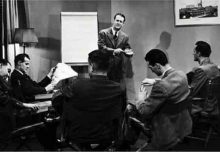Change, no sooner said than done?
Why is it so difficult to transfer changes from the boardroom to the workfloor? Why is it that many strategies crash before they have started? Why won’t “they” cooperate and how do I get them to join? These are mind-bending questions for lots of executives. As a behaviour expert and consultant I believe it is quite natural that people feel resistance to change. I will try to explain how you can provide a good ‘change climate’.
Who is messing with my fire?
As Abraham Maslow already discovered and represented in his hierarchy of needs, there are basic needs for people (such as food and heat), closely followed by the need for safety and security. Although we now seem to be evolved quit a bit since our ancestors were living in caves, our needs have not changed substantially. A steady job and a company car now substitute the basic needs like a warm fire in a cave. If you tamper with the basic needs of people, you are kind of putting out their fire. The reaction is not that different from the reaction of our cavemen ancestors.
It is therefore quite natural that we feel uncomfortable when we are pushed or pulled out of our comfort zone. Change leads to distress, in fact, the mere announcement of change leads to distress. What would you do when they put out your fire? Stay in the cold? Start looking for another cave? Your choice would probably depend on external conditions – how cold it is outside, and how uncomfortable do I feel?
The UPA model
A universal model to explain the process of change is UPA. (U stands for Urge, P stands for perspective and A for action). The Urge can be both negative or positive. This model is as old as mankind. It assumes that people only come into action when the amount of stress they experience evokes so much physical tension that they can’t take anymore, or, in the more positive scenario, when they see an attractive alternative, such as a larger cave with a fire.
Stuck in the middle
Most people in organizations are in between these 2 extremes. They are not uncomfortable enough, “I’m not really happy, but I am trying to live with it “. And they do not have a clear alternative perspective, “I don’t know exactly what my position in the new organizational structure entails.” They are supposedly stuck in the middle, the point at which nothing changes. If you want real changes to occur, it is important to regulate the tension by coming to action. To do this, you have to develop a new perspective. The question managers should NOT ask themselves is: “How do I get my people to do what I want?” but “How can I create a climate that stimulates the intrinsic motivation to change?”
Jeroen Bouman
Behavioural consultant, haptonomist




